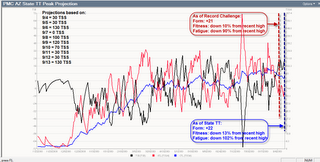A unique useage of the WKO+ software is projecting what to expect on race day. Accompanying is a screen shot of a Fitness-Fatigue-Form projection for an athlete I coach who has two A-priority races in the next two weeks - the Record Challenge TT in New Mexico on September 6 and one week later the State TT Championship (click to expand). The horizontal axis represents time from the start of his training season in November of 2008 (and recovery from a crash almost immediately) until September 13, 2009.
 What I've done here is to determine what the daily workout Training Stress Scores (TSS) need to be during his Peak period in order to produce a Training Stress Balance ('Form') of about +20. This helped me to decide on workout intensities and durations for each day of the Peak period. You can see here that his Form worked out to +21 for the first race and +22 for the second. So just about spot on.
What I've done here is to determine what the daily workout Training Stress Scores (TSS) need to be during his Peak period in order to produce a Training Stress Balance ('Form') of about +20. This helped me to decide on workout intensities and durations for each day of the Peak period. You can see here that his Form worked out to +21 for the first race and +22 for the second. So just about spot on.My other concern in projecting a Peak period is to keep Chronic Training Load ('Fitness') losses to around 10%. For the Record Challenge he will come to the race with a drop from his recent high point of about 10%. For the second race the cumulative drop will be about 13% from the same point. This is quite good also.
Should he have decided on including a third A-priority race a week after the second (he didn't) Fitness would drop even more. This helps to explain why it is so difficult to have several A-priority races in consecutive weeks. Fitness drops each week when peaking. That's because Fitness and Fatigue follow the same general trend. So when attempting to reduce Fatigue, Fitness also declines, just not as rapidly. And the longer the race is, the greater the drop. By the third or fourth week of continued Fatigue reduction, Fitness is likely to be so low that performance is significantly compromised. This is why I encourage athletes to have only about three A-priorities in a season and to space them several weeks apart, if possible. Of course, that's not always possible so you must then be aware of what the consequences may be in terms of race performance in the latter races and set goals and race strategies accordingly.
From Davy Gunn
From Davy Gunn
Summary. Prioritise and rest. Even though fitness will decline slowly during a rest period the net gain in performance on race day will be greater. The trick is how you optomise this - and this is why folk have a coach or personal trainer to take out the guess work. For us normal folk we can use HRM and keep a diary of training with an event plan, recording values, and importantly how it felt using perceived exertion scoring. Fail to plan and plan to fail. I use the WKO software but it's no better than the polar pro trainer although it does include power if you have a powertap or SRM. Where the software is good is comparing speed/time/HR which should remain paired in a TT, and show form.
I studied human and sports physiology some 22 years ago at what is now Telford University. Using myself as a Guinea Pig I made many errors in training which fitness and youth compensated for. As a senior vet I can't get away with that now and need all the help I can muster! Anyway Joe Friel is the master (although he must have shares in WKO!)
I studied human and sports physiology some 22 years ago at what is now Telford University. Using myself as a Guinea Pig I made many errors in training which fitness and youth compensated for. As a senior vet I can't get away with that now and need all the help I can muster! Anyway Joe Friel is the master (although he must have shares in WKO!)
No comments:
Post a Comment